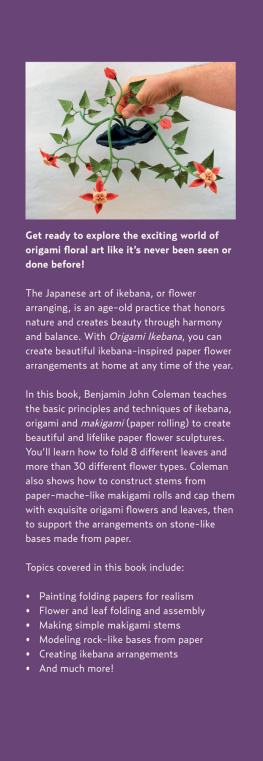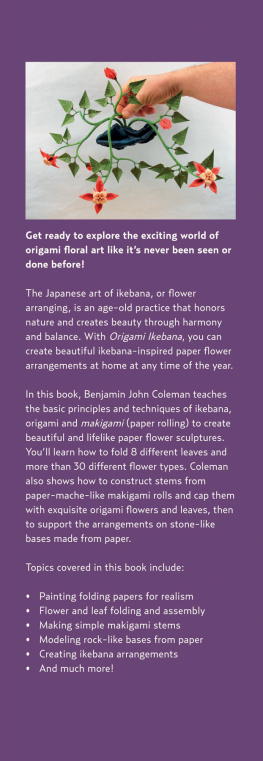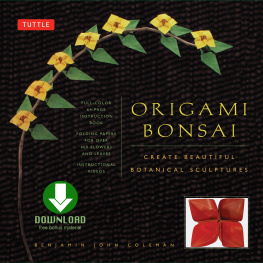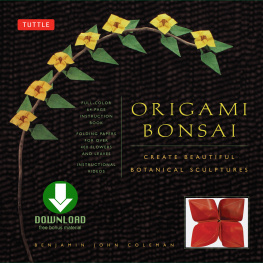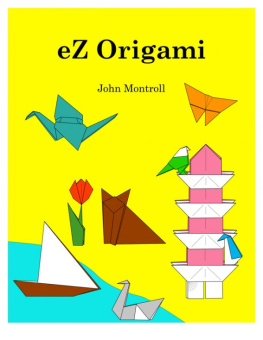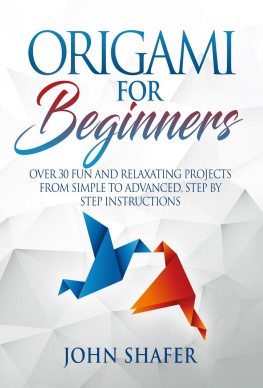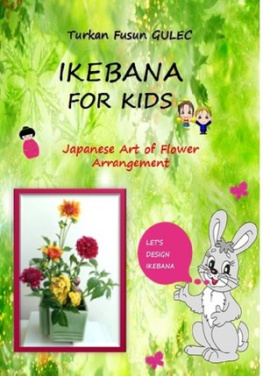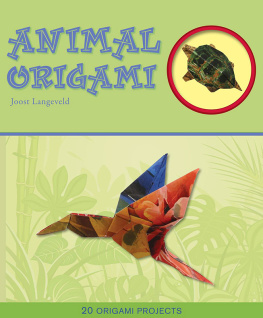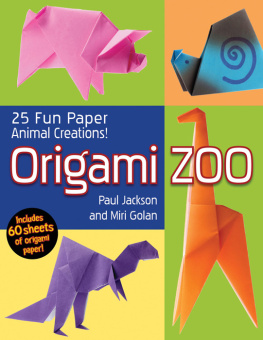Benjamin John Coleman - Origami Ikebana
Here you can read online Benjamin John Coleman - Origami Ikebana full text of the book (entire story) in english for free. Download pdf and epub, get meaning, cover and reviews about this ebook. year: 2014, publisher: Tuttle Publishing, genre: Children. Description of the work, (preface) as well as reviews are available. Best literature library LitArk.com created for fans of good reading and offers a wide selection of genres:
Romance novel
Science fiction
Adventure
Detective
Science
History
Home and family
Prose
Art
Politics
Computer
Non-fiction
Religion
Business
Children
Humor
Choose a favorite category and find really read worthwhile books. Enjoy immersion in the world of imagination, feel the emotions of the characters or learn something new for yourself, make an fascinating discovery.
- Book:Origami Ikebana
- Author:
- Publisher:Tuttle Publishing
- Genre:
- Year:2014
- Rating:5 / 5
- Favourites:Add to favourites
- Your mark:
- 100
- 1
- 2
- 3
- 4
- 5
Origami Ikebana: summary, description and annotation
We offer to read an annotation, description, summary or preface (depends on what the author of the book "Origami Ikebana" wrote himself). If you haven't found the necessary information about the book — write in the comments, we will try to find it.
Origami Ikebana — read online for free the complete book (whole text) full work
Below is the text of the book, divided by pages. System saving the place of the last page read, allows you to conveniently read the book "Origami Ikebana" online for free, without having to search again every time where you left off. Put a bookmark, and you can go to the page where you finished reading at any time.
Font size:
Interval:
Bookmark:
ASSEMBLING ORIGAMI IKEBANA
First, just to be clear, lets call this ikebana- inspired origami, because a quick search of book titles reveals that there are over 600 books about ikebana in the English language. If I could perform the same search in Japanese, we would probably discover thousands more. Ikebana is an esoteric subject, with a few specialists, and many professing knowledge. I make no such claim. In writing a book where only one section is dedicated to the subject of ikebana, it would be a challenge beyond my ability to include more than a modicum of the spirit of this art.
From the very start however, ikebana translates poorly into English. The common definition is Japanese flower arranging, which is not quite accurate. A more accurate translation, based on the characters making up the Japanese word ( ), reveals a different meaning. The first two symbols, , mean keep alive. The third symbol, , means flowers. In English keep alive flowers would mean to preserve them, and that would completely miss the spirit of this art form. More loosely translated, the three characters also mean living flowers in English. My research suggests that the meaning behind the concept, living flowers, conveys a more accurate portrayal of what people are trying to achieve when making an ikebana-style flower arrangement. My understanding is that ikebana is about our relationship to the natural world around us. It is an attempt to build balance, or a bridge, between what surrounds us; man-made things like walls, furniture, and decorations, and the living flowers in our arrangement. This is no simple task. Id like to show you pictures of spaces and then show how an arrangement can interact with that space, but this would require many more pages than can fit in this book. So, I urge you to obtain additional reading material on this art form so that your creations will more accurately reflect the spirit of ikebana. (Check out Ikebana: The Art of Arranging Flowers by Shozo Sato, Tuttle Publishing, 2013.)
Based on what Ive seen, good-looking ikebana arrangements have several common attributes. If we turn those common attributes into a set of rules for origami ikebana, perhaps well have a starting point for making some truly beautiful sculptures. Here are the rules I would suggest you try to follow when making origami ikebana arrangements:
INCORPORATE A SCALENE TRIANGLE
A scalene triangle is a triangle where no sides are equal in length. Perhaps the shape of the foliage forms the scalene, or three flowers define the points of the scalene. The scalene could reflect components of the space where it is going to be installed. Perhaps the shelf upon which the sculpture rests, and the wall it is adjacent to are reflected in two sides of the scalene triangle?
VASTLY VARYING HEIGHT
Try to include plant varieties that vary greatly in terms of their heights. Short flowers and tall grass make for a nice contrast in height, but also consider the space where the sculpture will be on display. How can you use the height of your plants to make the space more attractive?
VASTLY VARYING SHAPE
Contrasting shapes, such as Rotundifolius Leaves in contrast with straight blades of grass, fulfill the spirit of this rule. It is important to reflect the shape, in some form, of the space where the sculpture will be displayed. For example, if I were making a sculpture that were on display below an arched opening, I would try to include a geometric feature either similar to the arch, or in direct contrast to it.
ONE PERSPECTIVE
Design your sculpture to be viewed from one specific perspective. Maximize the visual complexity that is seen from one angle. When designing for a specific space, at what angle will the sculpture be seen? At what height will the viewer be looking? If the sculpture looks great from any angle, thats an added bonus, but try to design it so that one, specific view is best.
COLOR
Color is the single most important attribute of your work. When planning your sculpture, try to find colors that will compliment the surroundings. Using a color from trim or wallpaper nearby is not a bad idea. Using white when the only color surrounding your sculpture is white is probably a mistake, although Ive seen amazing things done with shades of gray.

A Simple Assembly
Your first assembly should be kept as simple as possible. In this example Im going to assemble an origami ikebana from three small flowering plants and some short grass.
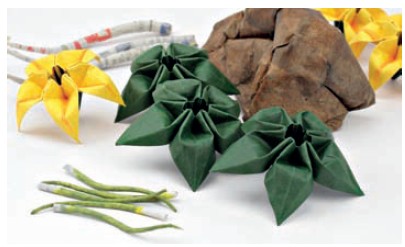
Gather the components of your sculpture and plan out the colors. I have very dark, short foliage so Ive chosen a lighter stone color to contrast with it. The lighter, yellowish-orange color also coordinates with my flowers.
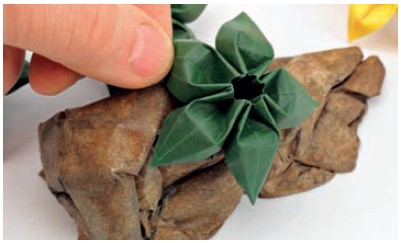
Determine how your plants will interact with the rock. Ill be inserting my plants into crevices in the rock. Notice how the foliage stands out against the color of the rock.

Trim your makigami stems, removing any paper that delaminated. (This photo shows unpainted stems being trimmed, but yours should be painted at this stage.)
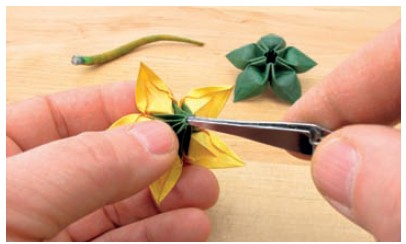
Next, assemble the flowers. Begin by poking a hole in the tip of the bud of each of the flowers.
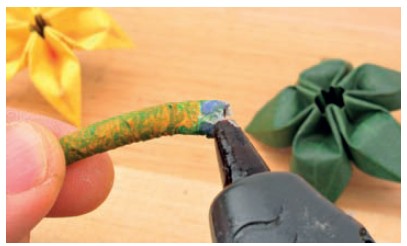
Put a small amount of hot melt glue onto the wide end of one of your stems and then insert it into center of the green flower youre using to represent the foliage.
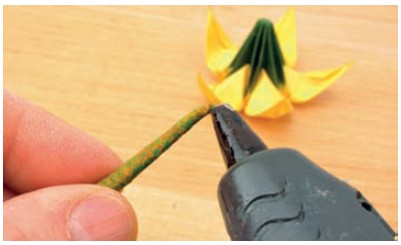
Put a small amount of hot melt glue on the narrow end of your stem and attach the flower to it.

Mount each plant onto your rock with hot melt glue. It is best to insert the base of each plant into a crevice or nook.
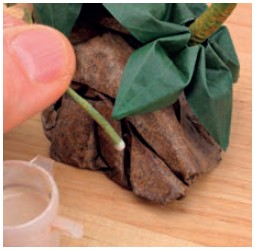
I like to cut my grass so that each is a different height. Then I dip each piece into glue and insert them into a crevice.
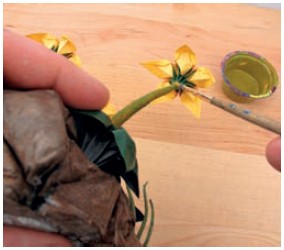
Mix a solution of 1 part acrylic paint, 1 part wood glue and 3 parts water into a color that matches the stems of your plants. Paint this mixture onto the hot melt glue you used to attach the flower to the stem.
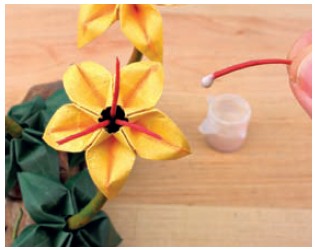
If you want to add stamens to your flowers, use the same method used to attach grass (step 8, above). I dont have a lot of space in the center of my flowers so I added only three stamens to each flower. Normally I would have added five.
Font size:
Interval:
Bookmark:
Similar books «Origami Ikebana»
Look at similar books to Origami Ikebana. We have selected literature similar in name and meaning in the hope of providing readers with more options to find new, interesting, not yet read works.
Discussion, reviews of the book Origami Ikebana and just readers' own opinions. Leave your comments, write what you think about the work, its meaning or the main characters. Specify what exactly you liked and what you didn't like, and why you think so.

